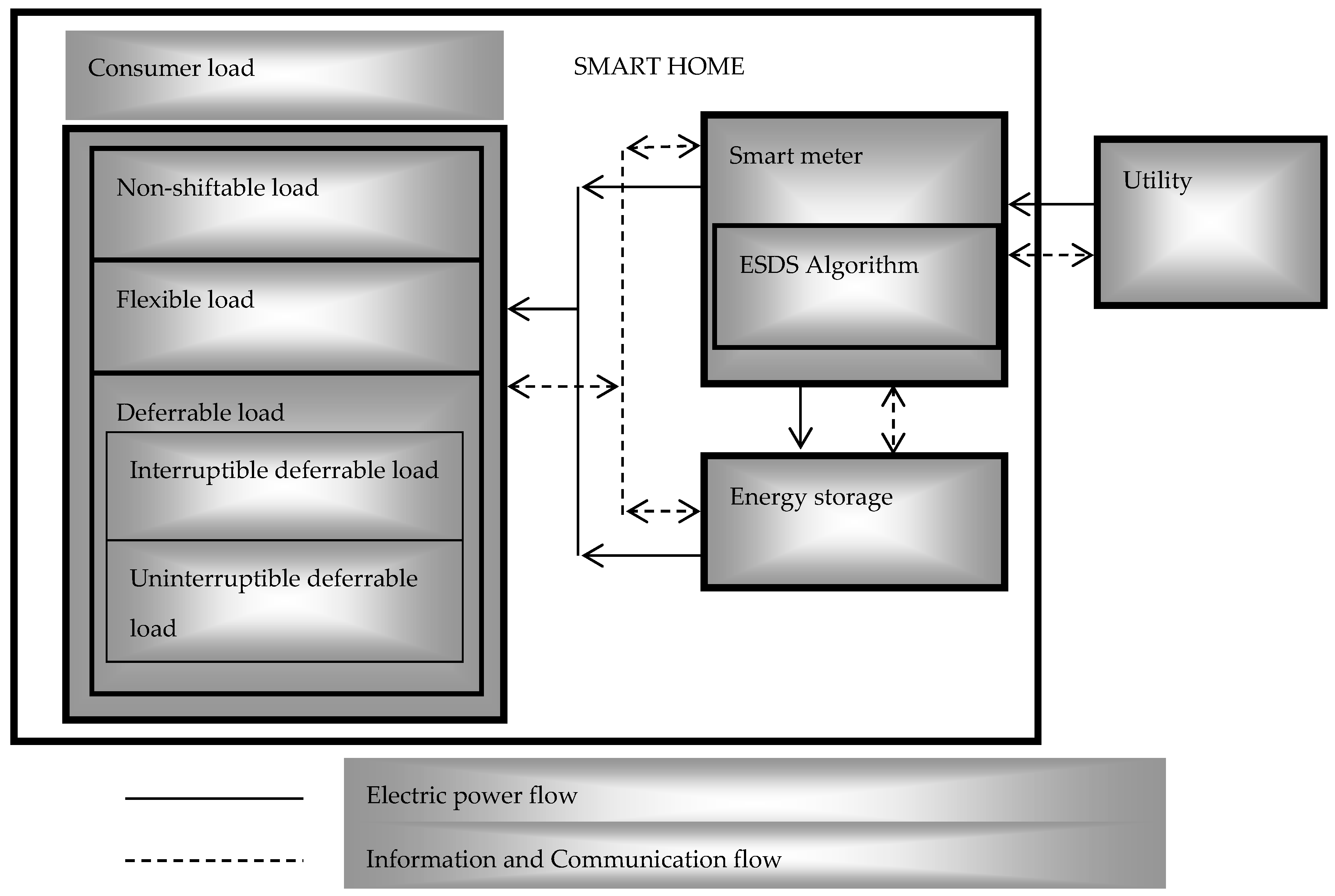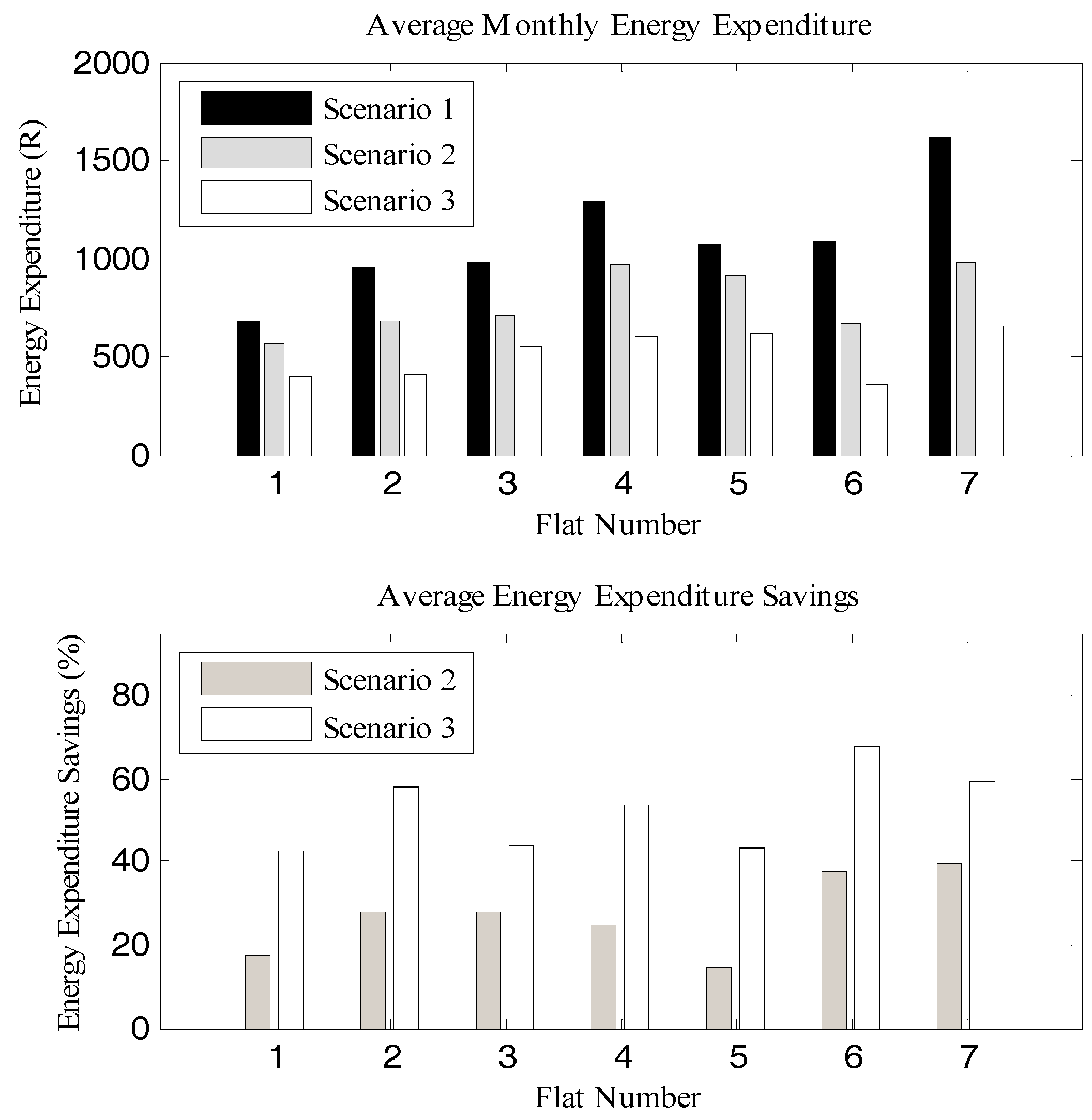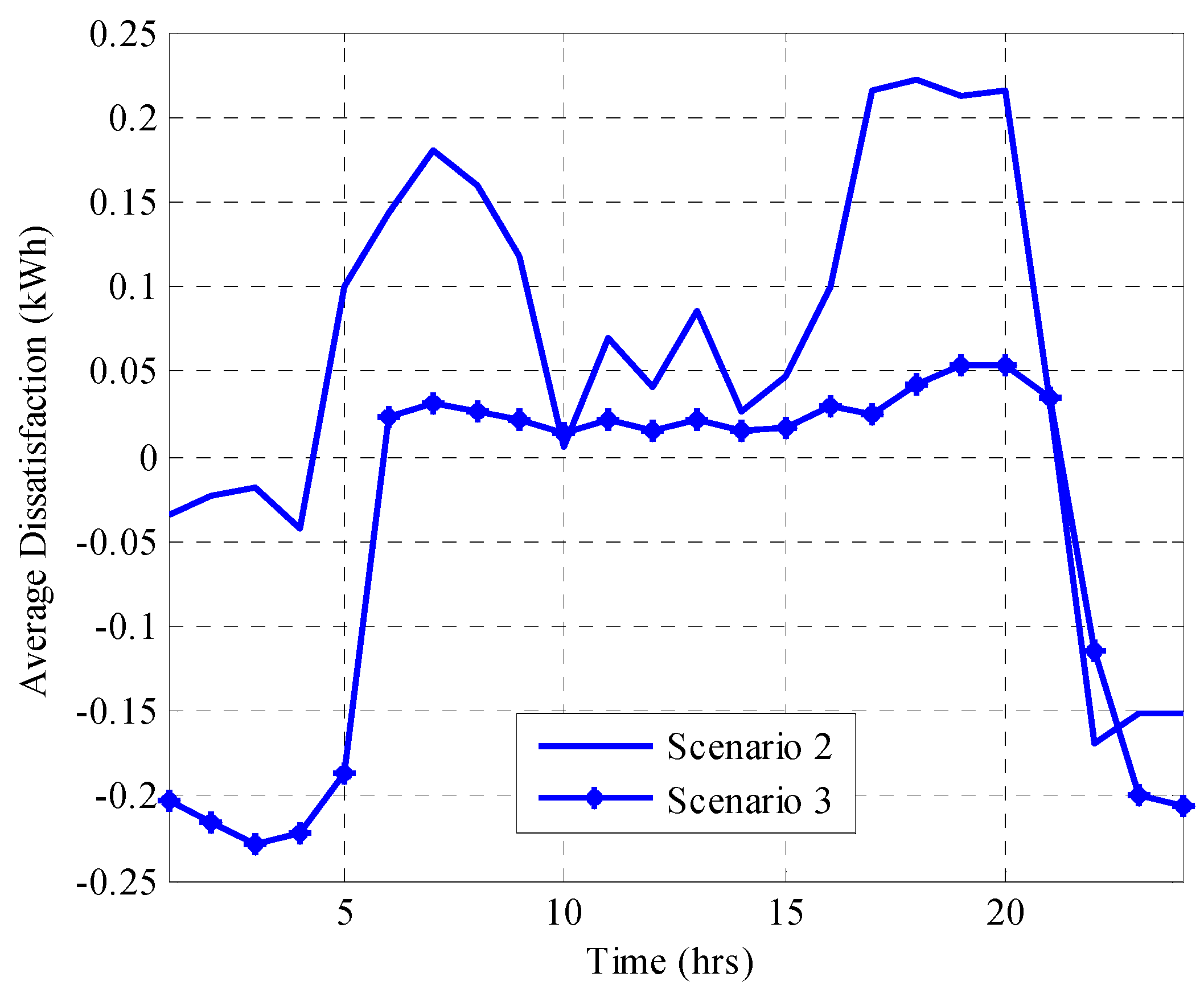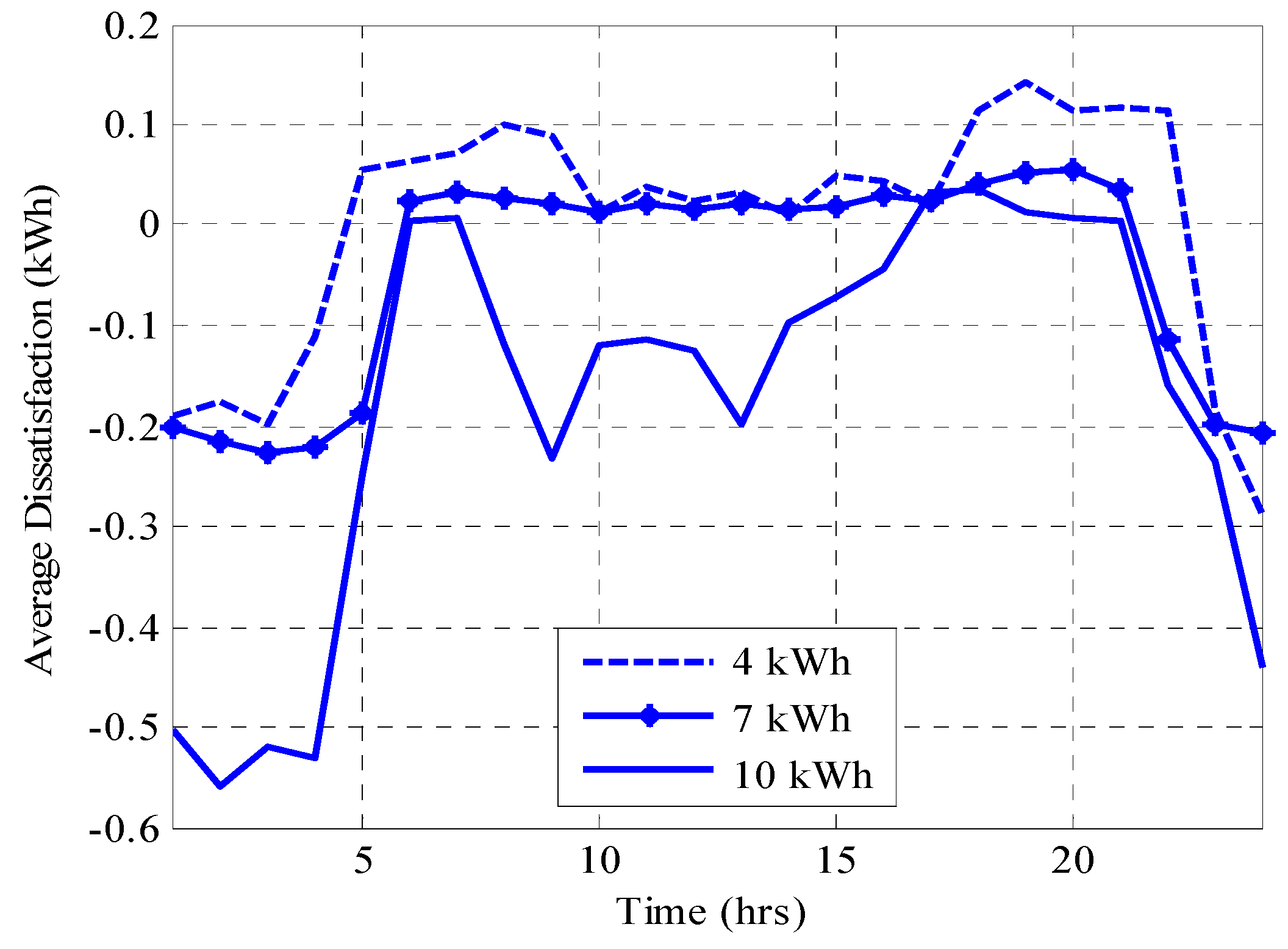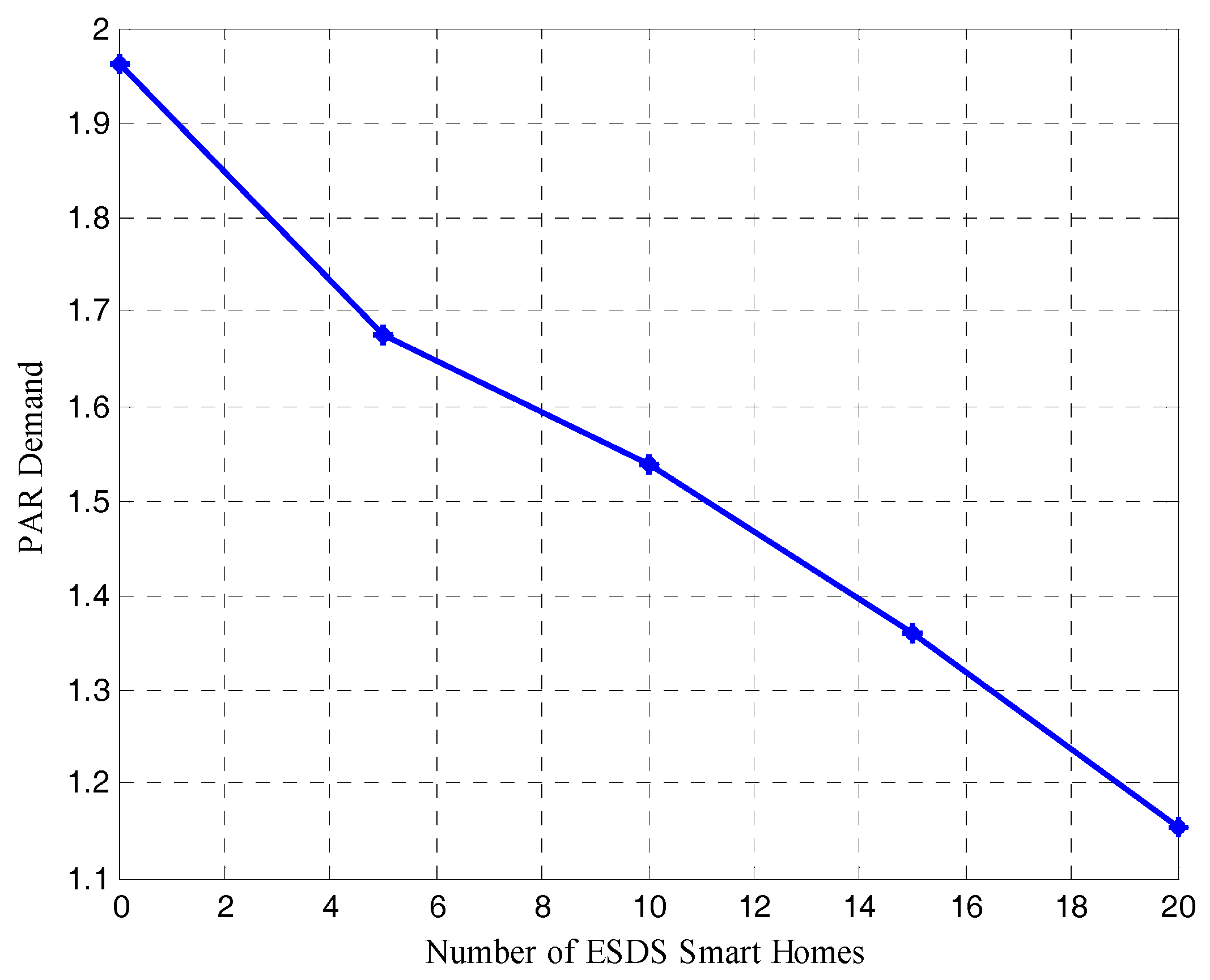1. Introduction
The smart grid is envisioned to offer grid reliability, sustainability, efficiency, and security with better consumer participation and environmental friendliness. It will be an environment with bi-directional flow of power and information between utilities and consumers through enabling information and communication technologies [
1].
Demand Side Management (DSM) is an essential component for smart grid goals to be achieved. Recent DSM studies [
2,
3,
4,
5,
6,
7,
8], have presented some techniques for appliance energy consumption scheduling, peak demand reduction (PDR), and Peak-to-Average-Ratio (PAR) demand reduction with some level of consumer preferences.
The need to enhance power supply stability in the grid has led to exploring additional power supply sources such as Distributed Energy Resources (DERs), for example, wind turbines and solar panels, and Distributed Energy Storage (DES), for example, batteries, electric vehicles, and fuel cells. Energy storage in batteries for use on consumer premises is promising due to recent development in battery designs with features such as larger storage capacities, longer discharge period, and better charging and discharging efficiencies [
6].
Generally, when consumers’ consumption is scheduled, it is the peak period demand that is often shifted to non-peak period, thereby leading to consumer dissatisfaction/discomfort. Hence, this work intends, through its proposed DSM algorithm, to offer PDR benefits to the utility with reduced or negligible peak period demand dissatisfaction to consumers, by optimizing energy supply and demand in consumer premises through the incorporation of an in-home DES device. The proposed Energy Scheduling and Distributed Storage (ESDS) algorithm will carry out energy consumption, storage, and expenditure optimization in the smart homes equipped with an in-home DES device. The ESDS algorithm optimizes energy demand and supply in the home between the grid and battery depending on grid energy price and consumer preferences. The ESDS optimization problem was formulated using convex programming and can be installed into smart meters on consumers’ premises.
The proposed algorithm would offer energy expenditure reduction and affordability, better consumer satisfaction even at peak periods, utility savings on peaker plants, reduced PAR demand and reduced carbon dioxide (CO2) emissions from peaker plants. Consumer’s privacy is also offered, since the consumers do not need to send their energy consumption schedule to everyone within the network, but to the utility only. This would, in essence, reduce signaling complexity and communication investment costs in the smart grid infrastructure.
The rest of the work is organized as follows. Some related literature on DES for DSM applications are presented in
Section 2, while a description of the ESDS model is presented in
Section 3. The ESDS problem formulation is in
Section 4.
Section 5 contains the simulation results and discussions while
Section 6 contains the conclusion of the work.
5. Simulation Results and Discussions
Household energy consumption data for 100 flats were obtained from Eskom Data Acquisition Department and fed into the ESDS algorithm for three scenarios namely: No DSM—Scenario 1, DSM without ESDS—Scenario 2, and DSM with ESDS—Scenario 3. Scenario 1 does not involve any optimization at all, as it is the obtained nominal consumption of the consumers. Scenario 2 solves (22) excluding all battery-related constraints, while Scenario 3 carries out the complete optimization problem as shown in (22).
The results of average hourly energy consumption and expenditure from the grid for flats 5 and 12 chosen at random during summer are presented in
Figure 2. It can be seen from
Figure 2 that Scenarios 2 and 3 outperformed Scenario 1 for both flats because of the optimization scheduling involved in their algorithms. However, Scenario 3 outperformed Scenario 2 for both flats. The household consumed the least energy from the utility grid during morning and evening peak periods under Scenario 3 since the battery was the primary source of energy at peak periods. This, therefore, led to reduced energy consumption from the grid during peak periods and, consequently, reduced energy expenditure and increased financial savings for the consumers. The energy consumed from the battery at peak time by the scheduled appliances is the energy bought from the grid at a non-peak (off-peak and standard periods) TOU (low) prices. Also, the aggregate energy consumption profile for the one hundred households is presented in
Figure 3.
Hence, the Scenario 3 (ESDS) algorithm would offer the consumers more financial savings than the Scenario 2 algorithm. Average monthly energy expenditure in the local currency of South African rands (R) for seven out of the twenty consumers chosen at random is presented in
Figure 4. Therefore, the consumers under Scenarios 2 and 3 algorithms were able to reduce their average energy expenditure, compared to Scenario 1. However, the financial savings on energy expenditure was higher for the consumers in Scenario 3 than for those in Scenario 2 due to the possession of DES in the consumers’ premises. The average monthly financial savings for all the households in Scenarios 2 and 3 were 27% and 53%, respectively. The battery payback periods are directly related to the amount of energy consumption and expenditure savings. The payback period on battery investment differ from one consumer to another within Scenario 3, and this depends on how much energy is scheduled for battery supply in the household.
Energy consumption scheduling on consumers’ premises has known advantages, but not without the disadvantage of demand dissatisfaction. However, the implementation of DES in an ESDS algorithm proposes reduced or negligible demand dissatisfaction cost. In terms of the dissatisfaction cost, it was observed that Scenario 3 offered lower dissatisfaction to consumers than Scenario 2 especially at peak periods. This is because the consumers under Scenario 3 had purchased energy from the grid at non-peak times (low energy price periods) and stored it in their batteries. This stored energy is primarily discharged locally to household appliances during morning and evening peak periods, and thereby mitigates the peak period demand dissatisfaction that characterizes the Scenario 2 scheduling algorithm like other DSM energy scheduling algorithms in the literature [
4,
5,
7]. The effect of DSM scheduling in Scenarios 2 and 3 on dissatisfaction cost is shown in
Figure 5. Dissatisfaction cost was not considered for Scenario 1 because it was the consumer’s traditional nominal consumption without energy scheduling and, hence, has no demand dissatisfaction cost.
The flexible appliances generate positive, negative, and zero demand dissatisfaction, while the deferrable appliances generate either positive or zero dissatisfaction depending on the load scheduling. Positive total daily dissatisfaction is not desirable for maximized consumer’s welfare. The desirable total daily dissatisfaction, for a consumer should be for consumer’s maximum social welfare and minimized energy expenditure. The simulation results showed that the average daily dissatisfaction for Scenarios 2 and 3 were 1.386 kWh and −1.065 kWh, respectively. This implies that the integration of the battery into the consumer’s premise offered reduced or negligible dissatisfaction to the consumers.
Also, further sensitivity analysis was carried out to investigate the effect of battery capacity on consumer’s dissatisfaction. It was discovered that the higher the battery capacity acquired by a consumer, the less it will be dissatisfied by appliance scheduling with respect to its average peak period demand. However, battery capacity cannot indefinitely increase; otherwise, the law of diminishing returns would set in for financial savings and battery pay-back period. The battery capacity assumed initially in the simulation was 7 kWh. Therefore, the effects of 4 kWh and 10 kWh battery capacities on demand dissatisfaction were studied, and the results found are presented in
Figure 6. The average daily demand dissatisfaction obtained were 0.063 kWh, −1.265 kWh, and −4.217 kWh for the 4 kWh, 7 kWh, and 10 kWh batteries, respectively. This implies that the 10 kWh battery capacities would not be economical for the consumers whose consumption data was simulated in this work due to very high satisfaction. However, the consumer can choose between the 4 kWh and 7 kWh batteries depending on their tolerance for dissatisfaction. From interpolation, it was observed that zero dissatisfaction can be achieved with approximately 5 kWh battery capacity. Too high satisfaction is not cost efficient because optimal satisfaction, expenditure savings, and good battery health intercept at zero dissatisfaction.
Hence, there is a need for consumers to seek technical advice before purchasing an in-home energy storage device for optimized satisfaction and energy expenditure. Also, the total daily morning or evening peak period demand can be used to determine the size of battery capacity.
The state of health and degradation cost of any battery depends upon factors such as its lifetime throughput, roundtrip efficiency, and replacement cost, among others. While state of health reduces with battery usage, degradation cost increases with usage and, consequently, the level of satisfaction that the battery can offer to the consumers will also reduce with time and usage.
The average PAR demand for Scenarios 1, 2, and 3 were found to be 1.961, 1.675, and 1.154, respectively, which are less than the results obtained in [
6]. Therefore, Scenario 3 would offer the utility grid better stability and reliability than others due to its lowest grid peak demand and PAR demand. Best satisfaction is obtained when dissatisfaction is zero. The more negative the dissatisfaction is, the lower the comparative advantage of a higher battery capacity on energy savings.
The relationship between number of ESDS smart homes in the smart grid and PAR demand was also investigated and the result is presented in
Figure 7. This sensitivity analysis was carried out on PAR demand because it may not be a realistic assumption that all the smart homes in a smart microgrid or smart grid at large would have battery storage facilities installed in their premises for DSM purposes. And as can be seen from
Figure 7, the higher the number of ESDS smart homes in a smart grid, the lower the PAR demand of the smart grid.
The relationship between battery capacity and aggregate PAR demand is presented in
Figure 8, and it shows that the higher the battery capacity of the in-Home Energy Storage (iHES) device, the lower the aggregate PAR demand from the grid. This was simulated for no battery (i.e., 0 kWh), 4 kWh, 7 kWh, and 10 kWh battery capacities.
The computational complexity involved in the ESDS algorithm is not beyond what can be solved in polynomial real time with an average computational time of 1.15 s depending on computer configuration. It can also be implemented into an embedded energy controller chip. Work is on-going on that in our laboratory. Practical implementation of the algorithm will be presented in future work. Limited security risk may arise, however, from the utility during communication.
Although the ESDS algorithm was tested for a TOU pricing scenario, it can also find application in a Real Time Pricing (RTP) environment by upgrading its pricing and demand response intelligence. Fundamentally, utilities set real-time energy prices based on the aggregate demand obtained from load schedule or forecasting. Therefore, energy prices are high at high demand periods and low at low demand periods. Hence, since the ESDS algorithm could minimize
, then it can also be used to obtain reduced grid energy consumption, energy price, and expenditure for RTP consumers also. The ESDS contributes to the sustainability of the grid and environment by reducing peak energy demand from the grid [
16] and offering a low carbon footprint [
17].
The payback period for consumers depends on level of energy savings, financial savings, and the healthiness of individual iHES devices. On the other hand, payback period for the manufacturer would depend on the rate of technology adoption, pricing scheme, and ease of implementation of the technology, among others. The continuous research and development in macro and micro-energy storage technologies show possibilities of a shorter payback period on investment for both consumers and manufacturers of storage devices in the smart grid.
